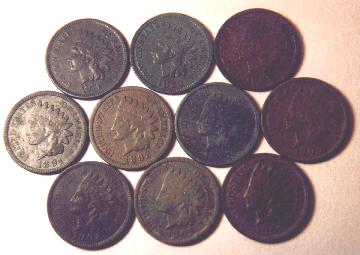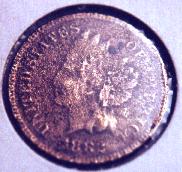
|
CLEANING COINS
When you get your finds home, just use a mild liquid hand soap and warm water. Place the coins in this mixture and let them soak for a few minutes. Then lightly brush them with a soft toothbrush, rinse with fresh water, then gently pat dry with a soft towel. This should be sufficient for most coins and there will be no need to go any farther! The silver coins in my area, come out of the ground clean and do not require any more work.
Some copper coins will have what looks like a scaley green crust on them. These will require a little more work to make them presentable for 'show and tell'. I've tried several methods for cleaning my older coins, the most reliable is the olive oil method. This is what I use on my really crusty coins that will have some moderate numismatic value.
 The oil will loosen up the crusted dirt so that you can use the soap and water method described above. This may take a long time. I've heard of some people soaking heavily crusted coins for up to a year!! I usually lose patience after a week or two, then start to go at the coins a little more agressively with the toothbrush risking possible scratches on the surface of the coins. This is what you should try to avoid. Imagine finding an Indian Head cent and putting a bunch of scratches on the face of the coin!! Not a pretty picture! This will reduce the value of any coin by 50% or more. I must mention that some of the "green" is desirable and gives a special character to each coin. This is what is called the "patina" and should be left on the coin. Notice the different colors on the coins on the right. I have also tried motor oil with great results.
The oil will loosen up the crusted dirt so that you can use the soap and water method described above. This may take a long time. I've heard of some people soaking heavily crusted coins for up to a year!! I usually lose patience after a week or two, then start to go at the coins a little more agressively with the toothbrush risking possible scratches on the surface of the coins. This is what you should try to avoid. Imagine finding an Indian Head cent and putting a bunch of scratches on the face of the coin!! Not a pretty picture! This will reduce the value of any coin by 50% or more. I must mention that some of the "green" is desirable and gives a special character to each coin. This is what is called the "patina" and should be left on the coin. Notice the different colors on the coins on the right. I have also tried motor oil with great results.
Words of Wisdom -- Take your time!! Taking the green crust off your coins too fast will cause "pitting".
 The coin on the left was done in a hurry using a mixture of white vinegar and water. It had a real crusty appearance, but I was impatient and wanted it clean right now. I wanted you to see how "ugly" this coin is, because I don't think you want your coins to look this way. At one time this could have been a reasonably attractive Indian Head cent, now it is worthless. I have cleaned coins using sulfuric acid at work and they turned out similar to this one! Yes it sure cleaned the coin in a hurry, but now I hate to even show this one with the rest of my coins. It sure works great as an example of what not to do. Some detectorists will use the vinegar method, maybe I used a rather strong mixture and should have diluted with more water, but why take the chance!
The coin on the left was done in a hurry using a mixture of white vinegar and water. It had a real crusty appearance, but I was impatient and wanted it clean right now. I wanted you to see how "ugly" this coin is, because I don't think you want your coins to look this way. At one time this could have been a reasonably attractive Indian Head cent, now it is worthless. I have cleaned coins using sulfuric acid at work and they turned out similar to this one! Yes it sure cleaned the coin in a hurry, but now I hate to even show this one with the rest of my coins. It sure works great as an example of what not to do. Some detectorists will use the vinegar method, maybe I used a rather strong mixture and should have diluted with more water, but why take the chance!
I have also used a rock tumble for the newer clad (dated after 1964) coins, but it is not necessary to clean them. Most banks will accept your clad coins if they are reasonably clean. If all else fails, I've put them into the vending machines at work. Its always fun to get one of your easily recognizable coins back in change!! Please remember those words at the top of this page -- If you think you've recovered a valuable coin -- DON'T CLEAN IT!! -- Let a professional do it. Even the most tiny of scratches on a valuable coin will decrease its value immensely!!!